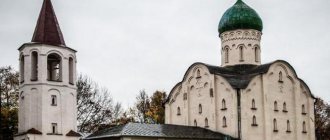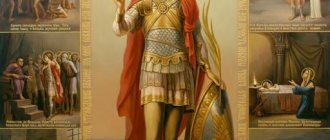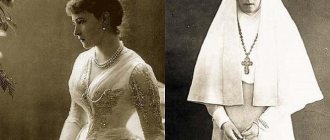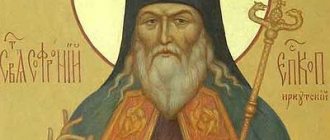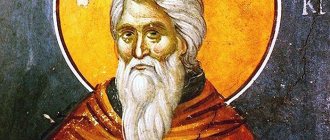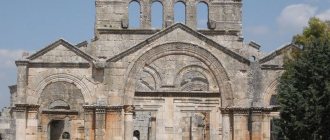Believers often turn to saints and ascetics in order to strengthen themselves in their righteous life, receive support, or even gain some kind of banal improvement:
- to be cured;
- get rid of passions;
- improve relationships.
The great ascetics of bygone times are especially popular, but even in modern times Orthodoxy knows a considerable number of saints who glorified the Lord with their miracles and helped many people. Such modern ascetics include, for example, the well-known John of Kronstadt, as well as the Saint Martha icon and prayer, which is considered miraculous.
At the same time, many believers have incomplete information and therefore may be a little mistaken in their religious practices. The veneration of Saint Martha and her miraculous icon is a typical example. Therefore, you should understand everything in order.
Saint Martha of Bethany - life and meaning in Orthodoxy
The name Marta in Russian sounds like Marfa. We know about Saint Martha of Beth from the narrations of the evangelists Luke and John about the resurrection of Lazarus. Martha was his sister and, in honor of the joyful event, invited Jesus Christ into the house. Her sister, Mary, did not help prepare the meal, choosing spiritual communion with the Savior.
Martha considered that such behavior from her sister was unacceptable when there were guests in the house, but Jesus Christ told her that everyone chooses their own path of service. The girl was among the wives who came to the tomb of Christ on the 3rd day to perform the rite of anointing.
Subsequently, Martha went with her brother to Cyprus, where she preached Christian teaching for 30 years. The Orthodox Church venerates St. Martha as the myrrh-bearing wife.
Saint Martha
She is mentioned several times in scripture. She lived at the same time as Jesus Christ. She had one more sister. Martha took care of the housework and constantly tried to please the guests. At the same time, her sister was far from this. She considered the preaching of Christ more important. She often listened to them and never helped her sister. One day, in front of her guest, Martha decided to reproach her sister and then heard from Christ that her sister was more worried about her spiritual salvation. And not scattered into earthly trifles.
The best article for you, go to: Prayer for your son and protection over him
The second time she is remembered is in the episode of the death of Lazarus. He was their brother. Who fell ill unexpectedly, just at the moment when Christ was far away. Without waiting for Christ to return, Lazarus died. But as soon as the Lord returned, he immediately healed the deceased, bringing him back to life. Martha is often considered a myrrh-bearing woman.
Martha Tsaritsynskaya - life and meaning in Orthodoxy
A young girl, whose name remains unknown, was born and graduated from high school in the city of Tsaritsyn (Volgograd) at the end of the 19th century. Wanting to take the path of serving the Lord, she went to St. Petersburg, where she met with John of Kronstadt, rector of St. Andrew’s Cathedral in Kronstadt.
The preacher, a spiritual writer, canonized after his dormition as a holy righteous man, blessed the young girl on the path of the foolishness of Christ for the sake of (renunciation of the usual blessings of life in order to testify to people about Christ) and ordered her to call herself Martha.
In 1908, after the death of Father John, the girl returned to Tsaritsyn, where she began serving the Lord, as the future saint predicted to her. For the sake of Christ, the holy fool lived in the open air, visiting families who observed Orthodox norms of behavior. Her visit was a good sign:
- conflicts stopped in the house;
- the sick were cured;
- material well-being improved.
Orthodox believers were glad to see Martha in their home. Wealthy townspeople, at her call, donated money for the construction of the Holy Spirit Monastery. As a sign of respect for blessed Martha, a cell was built where she received people who came for advice and consolation.
Martha of Tsaritsyn had the gift of healing and prophecy. She died in 1925, having predicted that she would be buried 3 times. Her first burial was in the Holy Spirit Monastery, then the remains were reburied next to the Alekseevskaya Church. After the temple was closed, the grave was moved to the Central Cemetery.
Even during her lifetime, Martha was called a saint, but she rejected such veneration. The Russian Orthodox Church has not canonized Blessed Martha, but people go to her grave to receive help and healing.
Martha of Moscow - life and meaning in Orthodoxy
It is known about Martha of Moscow that she lived at the end of the 16th and beginning of the 17th centuries, bore the name Daria in the world and was a nun of the Ivanovo nunnery. When she was tonsured she received the name Martha. The nun was so zealous in serving the Lord that she was awarded the great schema.
The Great Schema is a complete renunciation of earthly life, an ascetic retreat. But Martha went further in her ardent love for the Heavenly bridegroom: she became a holy fool for Christ’s sake. The voluntary suffering to which the schema-nun doomed herself - hunger, cold, heat - was reinforced by humble humiliation before people.
The head of the blessed one was a stone. She walked barefoot and half-dressed in winter and summer. On summer nights, Martha left the monastery on the Sparrow Hills, where she prayed to the Savior until the morning. Returning in the morning, I stood through all the services in the monastery church.
Despite external foolishness and crazy actions, people felt inner piety in the blessed one. The Holy Fool for Christ enjoyed special honor among the rulers of the Russian state, the Romanovs. Tsarina Evdokia Lukyanovna (1608-1645) often visited the schema-nun and asked her to pray for a safe birth and healthy babies.
The royal custom of serving a prayer service at her tomb with a request for help in childbirth was adopted by women of high birth and commoners. The holy fool for Christ died on March 1 (old style) 1638. By order of the tsar, the coffin with the remains of the blessed one was placed in the church of the Ivanovo Monastery, lined with bricks and covered with a tombstone made of white stone. The date and name of the deceased elder before tonsure and as a monk (Daria and schema-nun Martha the Holy Fool) were engraved on the tombstone.
Mikhail Fedorovich and Evdokia Lukyanovna continued to honor the memory of Martha: they visited her tomb, served memorial services, and handed over a cover embroidered with gold to decorate the tombstone. The descendants of the first Romanov couple considered her the patroness of the clan; the queens continued to visit the monastery and serve memorial services during pregnancy and before childbirth.
The nuns of the Ivanovo Monastery carefully preserved the tradition of the spiritual exploits of the holy fool for Christ, schema-nun Martha. Her name was included in the monastery calendar as a holy righteous woman.
In 1860, reconstruction of the old temple began. During the reconstruction, the remains of the blessed one, by decision of Metropolitan Philaret, were transferred to the monastery chapel. For this purpose, a wooden box was made, into which, after serving a prayer service, the coffin was carefully moved.
For 200 years, the lower boards of the wooden frame have been preserved. The bones were light yellow in color, untouched by decay, and retained the position of the body during burial. While the Trisagion was chanted, the box was moved to a temporary location. 15 years later, upon completion of construction, the remains were solemnly returned to the temple, where they were placed in a marble tomb.
Prayer services in honor of the blessed one resumed. The flow of believers increased every year due to miraculous healings from drunkenness and relief from labor pain. Evidence of Martha's appearances to nuns has been preserved. The first time she was seen was by the elders who remained in the Ivanovo Monastery, devastated by the French. Martha prayed at night in a temple illuminated by a wonderful light. Soon the monastery was restored with donations from the laity.
In 1878, the temple builder of the Ivanovo Monastery spoke with the blessed one. In her room, she saw an old woman in a monastic robe, lifting the icons standing on the floor for the iconostasis. Having answered the question that she was Martha from the Ivanovo Monastery, the nun disappeared. The temple creator took this as a sign that icons, even unconsecrated ones, must be treated reverently.
In the 20s the monastery was closed. In 1927, the saint’s relics were reburied at the Vagankovskoye cemetery, location unknown. Since 2001, the blessed one has been included in the list of Moscow saints; the day of remembrance is not marked in the general church calendar.
Character
Little Martha cannot be called her mother's favorite. Keeping secrets with her mother and trying to follow her in everything is not part of the plans of a mischievous and cocky girl. Dad is also not an authority for her, so Martha is often considered a rather difficult and disobedient child. She acts as a kind of tomboy, regardless of the age and authority of her friends or acquaintances. She can easily come into conflict with older children, defending her point of view. In this case, things can even come to a fight. Martha is not afraid of boys and girls, even if they are superior to her in age or physical development. To prevent such a trait, which can seriously interfere with Martha in adult life, from becoming entrenched in the girl’s character, parents should wean her from childhood to resolve her disputes with her fists and conflict with everyone who disagrees with her opinion. Although the girl often wins, she develops a certain brutality, so in adulthood she may suffer from a lack of grace and femininity.
Marta's activity and unstoppable energy continue throughout her school years. She continues to actively confront the whole world in various available ways, gathering around her a huge retinue of like-minded people. At the same time, Martha’s authority is often recognized not only by girls, but also by representatives of the opposite sex. It is not difficult for Martha to study; various sciences are easy for her. From an early age, a girl determines her future profession and does everything possible to achieve her goal. If little Martha decides in childhood to become a famous lawyer or artist, she will do everything possible to develop the necessary qualities and achieve visible heights in her chosen field. Growing up, Martha does not change her plans and continues to improve her existing skills.
Since Marta is an unusually active girl, she often enrolls in sports clubs. At the same time, Martha’s energy may well be enough even to visit several sections at the same time. The girl achieves significant success in sports and often goes to various Olympics. She often wins such competitions, so the school adores Marta, who constantly brings various medals. Physical education teachers, the class teacher and the head teacher treat her especially well. By high school, Martha herself sets the rules of life, trying not to break them and to persuade other children. A fighting character allows you to maintain authority and easily impose your opinion on weaker peers. Martha often tries to force the whole world to live by her rules, so those around her often move a certain distance away from the powerful girl who loves to command and teach life. Such an attitude and blind confidence in her own rightness often prompts Martha to conflicts with disobedient or headstrong allies who try to do things their own way. Trying to prove that she is right, she can say a lot of rude things and humiliate her opponent as much as possible, even if he was previously her faithful friend.
After graduating from school, the girl begins to react rather painfully to various life failures, problems and conflicts. She retains an irresistible desire to always restore justice, so she often makes enemies in the form of friends, relatives and parents. However, deep down Martha is an unusually vulnerable and kind person. Since from childhood a tomboy always learns to restrain her emotions and create the appearance of a confident winner, in adulthood it is difficult for her to remove the ingrained mask and reveal real feelings. She perceives all manifestations of kindness, compassion and understanding as a weakness of character, so she hides such traits from almost everyone around her.
Adult Martha becomes a very sociable and witty person. After many years of preparation for her chosen profession, she begins to perform her job duties with deep knowledge of the matter. By this time, Martha has acquired some grace skills, so when necessary, she becomes a lovely lady with refined manners. After establishing her character, Martha no longer tries to hide behind some kind of mask. She firmly believes in her superiority over other people, and is also distinguished by extraordinary determination, maintaining her former activity. Women's gossip and gatherings do not interest her as before, so she has practically no friends. Martha feels much more confident when surrounded by members of the opposite sex. She knows how to make the necessary impression on men, so she almost immediately becomes the life of the party. Men especially appreciate her good figure, smartness, and logical thinking. Marta often encourages the male team to go on vacation, which involves kayaking down a mountain river or going to a ski resort. At the same time, all of Martha’s friends know about her reliability and ability to always come to the rescue.
Naturally, Martha does not suffer from a lack of male attention; the number of her fans is quite large. However, she is in no hurry to tie the knot with one of the stronger sex. She is looking for a permanent and faithful man who agrees to a fairly open relationship without clear restrictions. But a girl’s first marriage most often turns out to be unsuccessful, so she marries a second time. The second husband shows Martha the delights of family life, so she becomes an excellent housewife, mother and wife next to him.
Martha may have the happiest marriage with Harry, Kolya, Borey, Robert, Averyan, Dima and Egor. At this time, her name is not very successfully combined with Bogdan, Max, Pasha, Seryozha, Abraham, Alyosha, Bogdan, Zhenya, Kliment, Misha, Ignat, Eldar, Tolik and Vitya.
Martha always tries to test possibilities by getting into hopeless or critical situations. They activate all her boundless energy, forcing her to use all her existing talents. She always wants to be better than those around her, so that her name will be remembered for many years or even included in books. But having suffered a number of failures, Martha often withdraws into herself, preparing for new challenges. She begins to mentally prepare herself for the upcoming loneliness. If Martha does not direct all her strength to leadership and manifestation of her main qualities, her spirit of a fighter may completely fade, giving way to depression and oppression.
The most difficult problem for Martha is curbing her despotism. However, this task is quite feasible, because it always remains straightforward, and in case of conflicts it quickly moves away. Curl, greed and greed are alien to the defender of justice Martha. At the same time, intimacy is also not among the main life goals of the owner of this name. An intimate relationship only confirms Martha’s superiority in her own eyes. The main goal of Martha’s life is the acquisition of high spiritual values, as well as constant self-development, necessary for the constant reinforcement of high self-esteem.
Iconography
Saint Martha of Bethany is depicted among the myrrh-bearing women, either with her sister Mary, or in an individual image. She is wearing a blue scarf/veil, and in her hands is a vessel with incense. The Cappadocian Martha in the icon stands next to the pillar on which her son, the righteous Simeon, sits.
The miraculous mosaic image of Martha of Moscow on her marble tombstone has been preserved. Located in the church of St. John the Baptist Monastery. The blessed one, dressed as a schema-nun, holds a cross in her right hand and blesses the believers with her left.
Blessed Martha of Tsaritsyn is not canonized; her image is absent in iconography.
What is asked of Saint Martha?
Saint Martha (of Bethany, Moscow) helps if people turn to her with a request:
- recover from a serious, chronic illness;
- find a good husband;
- get pregnant;
- solve material problems.
It is believed that the prayer to Saint Martha of Moscow helps to fulfill any desire if it is precisely indicated in the prayer address.
Congratulations to Martha on her name day
Martha, I wish you wonderful, unearthly love on your beautiful day. Let there be more than one reason to celebrate the name day. I wish you warm words, gifts, keep your face, posture, brand. So that in the company of anyone you shine like a bright star.
Today is a holiday - name day. Your bright and innocent Angel, Martochka, meets with you, a wonderful unearthly holiday. Let flowers, gifts, congratulations lift your spirits. I wish you an easy life, happy and not lonely!
May your wishes come true, Martha, on the day of the Angel appointed by fate! Say goodbye to your grievances and enjoy the beautiful times. May happiness never end, May success always accompany you in business, May men give you affection and attention, May your cheerful laughter never cease!
Martha, you are beautiful! And today, it’s not in vain that you get pleasure from good congratulations. The name day holiday has arrived! The Lord sent an angel. May he help you and not leave you in trouble!
Dear Martha! Congratulations on your name day! We wish your life to be an exciting journey, in which there is only joy and happiness. Let your dreams turn into reality. Happy Angel Day!
Prayer text
Prayer to the holy image of Martha of Moscow:
“Oh, Saint Martha, you are miraculous, I resort to you for help and completely rely on you that you will help me in my needs and be an assistant in my trials... I humbly, tearfully ask you to console me in my care and burden. For the sake of the great joy that filled your heart when you gave refuge to the Savior of the world in your home in Bethania, I beg you to worry about me and my family, so that we keep our God in our hearts. and thus we have earned the Saved Almighty mediation in our need, first of all, with the anxiety that worries me (indicate desire). Mother of God, I ask you to help me as a helper in every need, so that through the mediation of Saint Martha I can overcome my burden and care, which I named/named as you defeated the ancient serpent and laid it at your feet.”
“Prayer to Saint Martha for a wish” is not Orthodoxy, but superstition
The so-called “Prayer to Saint Martha for the fulfillment of a wish” has become widespread on the Internet. However, this text is not Orthodox. Here is what Archpriest Konstantin Parkhomenko says about him:
“People who have religious taste, who know what Orthodox prayers sound like, see that this is a fake.”
This text is replete with formulations that are unnatural for genuine prayers. The priest suggests that it is based on Western prayer books. It was significantly distorted and adapted by illiterate people to the needs of modern society.
Orthodox Christians should remember that it is not the saints who fulfill our requests, but only God according to their prayers. However, in the text we are considering, Saint Martha is presented as the sole helper of people. There is also a promise to spread this “prayer” among people as a sign of gratitude. In this way, the text is likened to magic spells, which are characterized by the formula “service for service.” The “prayer” is similar to occult texts by the recommendation to read it only once, as well as the promise of the onset of the effect even before the end of the reading.
However, genuine prayer is a prayer to the saint imbued with a repentant mood and trust in the will of God. The desire for a guaranteed result is inherent not in Christian, but in magical thinking. There is not even a hint of repentance and correction of the soul in the text. The emphasis is placed precisely on worldly well-being and deliverance from everyday hardships.
“Prayer to Martha for the fulfillment of a wish” is published on dubious Internet sites that only pretend to be Christian. In fact, they popularize religious ignorance, superstition and witchcraft practices (spells, amulets, etc.). Such sites can be easily identified by headings such as “Strong prayer for good luck”, “Prayer for money”, “Prayer for fulfillment of desires”, etc. Archpriest Konstantin Parkhomenko instructs:
“Do not access sites that mix the pious with the occult.”
And he advises to resort to trusted Orthodox Internet portals, where authentic prayers are collected, including to St. Martha.
